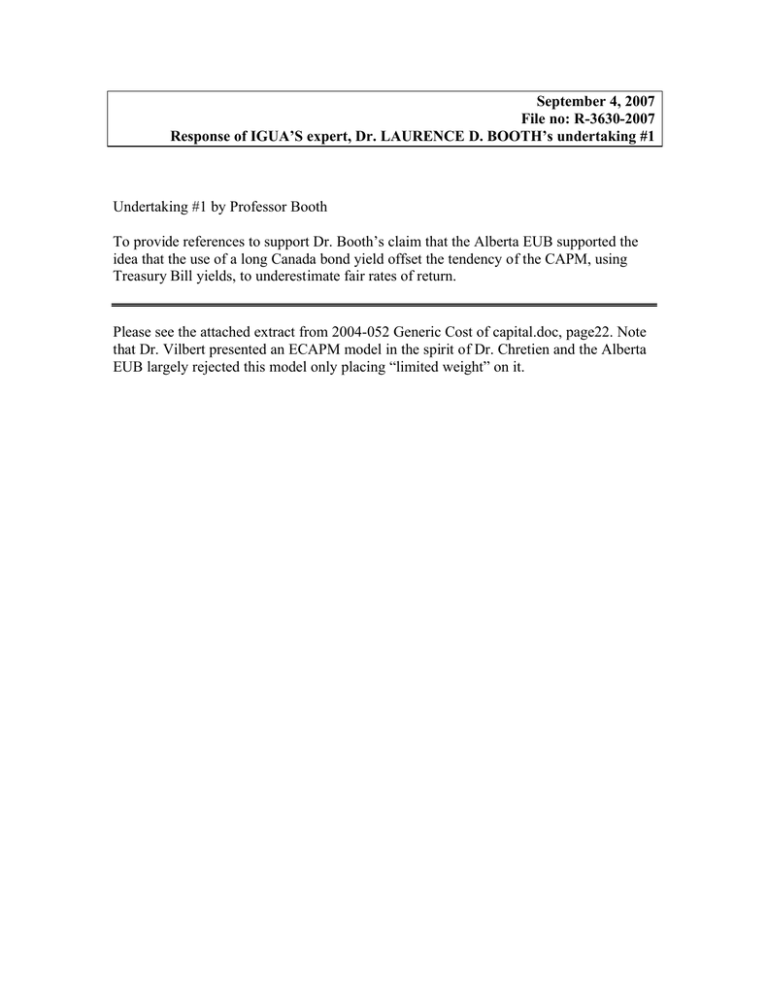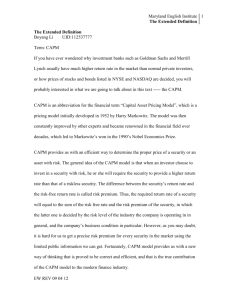September 4, 2007 File no: R-3630-2007
advertisement

September 4, 2007 File no: R-3630-2007 Response of IGUA’S expert, Dr. LAURENCE D. BOOTH’s undertaking #1 Undertaking #1 by Professor Booth To provide references to support Dr. Booth’s claim that the Alberta EUB supported the idea that the use of a long Canada bond yield offset the tendency of the CAPM, using Treasury Bill yields, to underestimate fair rates of return. Please see the attached extract from 2004-052 Generic Cost of capital.doc, page22. Note that Dr. Vilbert presented an ECAPM model in the spirit of Dr. Chretien and the Alberta EUB largely rejected this model only placing “limited weight” on it. 1. The adjustments that Dr. Booth indicated were required in developing the model.1 Dr. Vilbert (sponsored by NGTL) used both a CAPM model and an ECAPM model. His ECAPM model included an adjustment factor to compensate for an alleged tendency of CAPM models to under-estimate required returns for lower risk companies. Dr. Vilbert’s ECAPM model resulted in a recommendation for an 11% ROE on a 40% common equity ratio. Dr. Vilbert’s ECAPM results would directionally support an increase from the midpoint of the Board’s CAPM range. The Board notes Calgary/CAPP’s argument that applying CAPM using long-term interest rates (long-Canada bond yields) in determining the risk-free rate, as was done by all experts in this Proceeding, already corrects for the alleged under-estimation that ECAPM was designed to address.2 Calgary/CAPP argued that the under estimation would only be present if the CAPM were applied using short-term interest rates, which none of the experts did in this Proceeding. The Board finds the Calgary/CAPP position persuasive and considers that the use of long-term Canada bond yields largely adjusts for the tendency of CAPM, when based on short-term interest rates, to under estimate the required returns for lower risk companies. Therefore, the Board will only place limited weight on the results of the ECAPM model. Ms. McShane (sponsored by AltaGas/ATCO) used a DCF-based ERP test that resulted in a utility risk premium of 4.9%.3 The Board notes that this implies a total utility ROE of 11.15%, after adding her recommended risk-free rate and the flotation cost. Ms. McShane also provided a realized historic utility ERP, based on Canadian and U.S. utility returns, which indicated a utility risk premium of 4.75%.4 The Board notes that this implies a utility ROE of 11.0%. Dr. Neri applied two ERP tests in addition to the CAPM, based on U.S. electric utilities and on U.S. gas distribution utilities, which produced utility equity risk premiums of 5.14 and 5.53%,5 respectively. The Board notes that this implies a total utility ROE of 11.79% and 12.18%, respectively, after adding Dr. Neri’s risk-free rate recommendation of 6.15% and a flotation allowance of 0.50%. The Board notes that these utility return results of Ms. McShane’s and Dr. Neri’s other ERP tests are higher than many estimates of the market required return. Ms. McShane’s and Dr. Neri’s other ERP tests would directionally support an increase from the midpoint of the Board’s CAPM range. However, the Board shares CG’s6 and CAPP’s7 concern that it is not reasonable for the prospective required return on low risk firms to be close to or above the prospective overall market return. 1 2 3 4 5 6 7 Exhibit 016-11(a), Evidence of L. D. Booth, page 26 Calgary/CAPP Argument, page 12 Exhibit 005-10-2, Kathleen McShane, page 33 Ibid. Exhibit 009-02(b), Schedules 6&7 CG Argument, page 49 CAPP Argument, page 17


